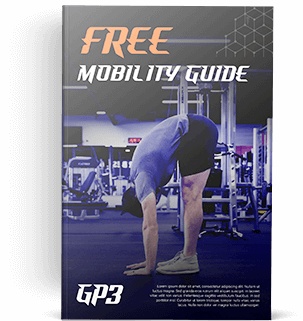Key Points:
1. Most athletes, from the professionals to the weekend warriors, are physically unprepared for the demands of their sport.
2. That might sound like a bold claim, but injury data supports it.
3. The truth is, most athletes are overtrained and under-recovered. It’s become a competitive advantage to take time off and actually do the strength and mobility work that helps you handle the demands of your sport.
Estimated reading time: 5-10 minutes
Is playing sports actually good for you? This is certainly something we’re taught as kids.
The truth is, playing sports is a net negative.
Just kidding!
If you’ve read at least a couple of my blog articles, it won’t surprise you to hear that this isn’t a black-and-white issue that we can simply label as “good” or “bad.” Very few things are. So instead, in this two-part series, we’re going to look at some of the benefits of sports and hidden pitfalls that can arise out of them. We’ll also examine some explicitly detrimental facets of participating in sports, and how to navigate the complex dance between all of this.
You ready? Good!
“Sports are good for you. Professional sports…not so much.”
I recently heard this line on a soccer-focused podcast. Essentially, they were talking about the extreme wear and tear professional sports places on players’ bodies. And it certainly does take its toll.
It’s not uncommon for top pros to average more than a game per week across the entire 12 month calendar. According to transfermarkt, a soccer nerd’s heaven of statistics and data, 447 players across all of the world’s professional leagues played in 52 or more matches in the 2021/22 season. This included games for the clubs that employed them, as well as games for their national teams. Further, 117 of these players met the magical threshold of 4,680 minutes. This meant they played the equivalent of a full 90-minute match, once per week, for an entire year.
You see, if you’re an international-caliber soccer player, you basically don’t have an offseason. Preseason starts in early July, and the regular season runs from mid-August to late May. That only leaves you six weeks of no club soccer. But…this becomes especially tough when there’s a major international tournament in the summer, which is at least every other year. So basically, you might get a couple weeks off in May, and a few days off in January, but that’s about it.
American professional athletes have much longer offseasons, but they also have way too many games crammed into a shorter timeframe. Basketball and hockey feature 82-game regular seasons plus the playoff grind, baseball has a 162-game regular season plus playoffs, and even though there are only 17 regular season games, football is football. I’m surprised there isn’t an injury on every play.
Frankly, it’s a miracle more injuries don’t occur. So, this got me thinking…
Sports are a form of intentional but unregulated overtraining
At least, they are in the way they’re executed at most levels. When you play as many games as a professional athlete, it’s simply not possible for your body to fully recover between matches. They will certainly do everything they can, with world-class nutrition, massage, and questionably effective interventions like hyperbaric chambers and ice baths, but it’s not enough. This overtraining isn’t just limited to professional sports, however.
In many ways, it’s often worse at the lower levels. It’s not uncommon for youth sports to have tournaments where kids play multiple games per day on a Friday, Saturday, and Sunday. Unless they play football, high school and college athletes typically play two or three matches per week. Plus non-professional athletes don’t have access to expensive recovery methods and optimal nutrition like the pros do, they rarely sleep enough, and they have massive levels of stress from balancing all of this with schoolwork. This isn’t even counting the physical exertion from practices!
You see, I used to wonder why I felt less explosive and more tired at the end of a college soccer season than I did at the beginning. “I’ve just played so many games…shouldn’t I be fit? I guess the answer must be more sprints for better conditioning!” Ah, the naivete of a young athlete. The truth is, I wasn’t under-conditioned, I was under-recovered. I needed to be doing less, not more.
This overtraining has its roots in the reality that most sports coaches are not strength coaches or exercise scientists. Their expertise is in the skills and strategies of their specific sport, not actually preparing the body to play it.
Further, it’s considered a luxury for high school sports programs to have a strength and conditioning coach, let alone one that isn’t shared across all teams. And youth clubs? Forget about it. So, the end result is that kids play way too much and don’t do any of the strength and mobility work that will better equip them to handle it.
But here’s the thing…when you’re under 18, you can just about get away with this. The average sixteen year-old does recover way faster than the average twenty-six year old. So, they can handle a higher playing volume. Until they can’t. This incredible 2-part series about the current injury crisis in basketball mentions that it’s now no longer considered shocking to perform ACL surgery on pre-teens. Let that sink in a moment.
Sports and the “No Pain, No Gain” mindset.
So far, I may have come across as quite anti-sport. I want to make it clear that this couldn’t be further from the truth. I have and continue to absolutely love sports. I still play soccer nearly every week, and I intend to continue doing so well past retirement age.
But, I now have a much healthier relationship with sports than I did when I was younger. Much of that stems from this aforementioned “push through what you’re feeling” mindset.
To be sure, there is tremendous value to be found when this is applied appropriately.
Pushing through the discomfort of fatigue, self-doubt, and the little voice that says, “I don’t wanna…” to make the crucial play that helps win your team the game is simply beautiful. We’re all capable of so much more than we know, and sports are one avenue that helps us realize this potential.
Sacrificing one’s own desires and comfort for the shared purpose of the team is noble and highly beneficial to athletes of all ages. But, playing while injured and through actual pain is a different story. Doing this makes you worse in the long run. There can be no arguing this point.
If I had things my way, there is only one circumstance in which an athlete would be allowed to play through actual pain: A professional athlete, in the championship game, before a long offseason. Even a playoff quarterfinal or semifinal wouldn’t clear this high bar. Let’s say a player makes it through an elimination game despite playing hurt. They’re now further away from a full recovery than before, and let’s not pretend the coach is going to let them sit out the next game.
Normalizing the dangerous
And yet, all of this is accepted as completely normal. It’s just, “part of the game.”
A recent example from last year’s soccer season highlights this perfectly. Steven Gerrard, legendary midfielder for Liverpool F.C. and England, now manager of the club Aston Villa, had some interesting things to say after his team lost to Arsenal F.C. Bukayo Saka, the young star player of the opposing team, was bleeding from the ankles after the game due to all the times he was fouled. Said Gerrard,
“He’s a good player, he’s an outstanding talent and I love him. But he can’t complain about that side. That’s football. I’m sitting here now with screws in my hips, I’ve had about 16 operations, I’m struggling to go to the gym at the moment. That’s all on the back of earning a living in English football. He’ll learn and he’ll learn quick.”
At the time of this quote, Steven Gerrard was only 41 years old. At the risk of sounding like a teenager trying too hard to be cool…
Bruh. Sixteen operations?
I don’t buy for a moment the argument that professional athletes are basically modern gladiators who get paid incomprehensible sums of money to sacrifice their bodies for our enjoyment.
I’d like to think we as a species have evolved further than that. We need to recognize our shared humanity and say that this is an unacceptable price to pay for entertainment. They should absolutely be expected to “give it their all” on the field, but they don’t need to end their careers with broken bodies.
Here’s a revolutionary idea…just play less often.
Apologies for turning this into a soccer-specific diatribe, but hey, you write what you know. Of course, people will argue that there’s less money to be made with fewer matches. But there’s also less money to be made with lower-quality matches.
Every winter, the top soccer league in the world, the English Premier League, has a curious tradition. Between the two weeks containing Christmas and New Years’ Day, most teams play four full matches in 10 days. Traditionally, footy fans love that there’s soccer on TV basically every day during a celebratory, joyful time of year when work responsibilities also tend to wind down.
But…the matches often suck. Yeah, yeah, insert joke about soccer being boring all the time. However, it’s simply not exciting to watch deeply exhausted players half-heartedly chase the ball around or pull up with a torn hamstring.
Believe it or not, I have a lot more to say about this topic. But, you’ve given me your attention long enough today already, and for that, I’m grateful. Next week, we’re going to dive a little deeper, and focus on how sports can contribute to a disconnect from the body, pitfalls of my favorite subject: identity, and how to navigate all of this.
Stay tuned!
Before you go, I’d love to hear from you! Think back to your playing days. Do you think you were ever overtrained? Can you recall a time when the “no pain, no gain” mindset got you into trouble, or has it always served you well? Reply to this email and let me know!

